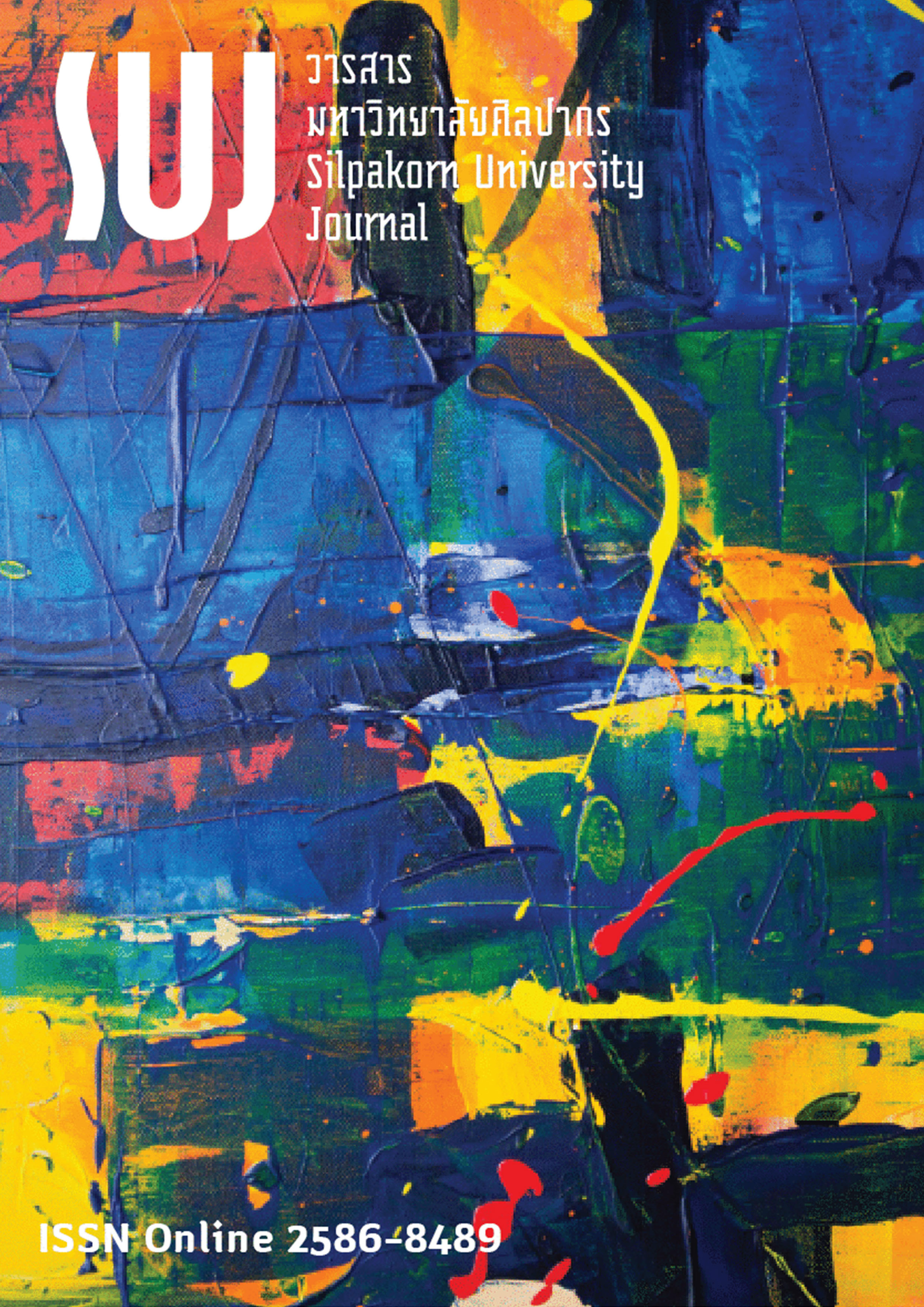การศึกษาปัญหาสุนัขจรจัดในบริบทชุมชนเมืองสู่แนวทางการแก้ปัญหาด้วยสถาปัตยกรรมขนาดเล็ก (A study of stray dog problems in urban contexts for alternative solutions with a small-scale architecture)
Main Article Content
Abstract
สุนัขจรจัด เป็นปัญหาที่ฝังรากลึกอยู่ในสังคมไทยมาอย่างยาวนาน ในแต่ละปีประเทศไทย ได้สูญเสียงบประมาณจำนวนมาก เพื่อใช้ในการจัดการกับผลกระทบที่เกิดจากสุนัขจรจัด ทั้งเรื่องวัคซีนพิษสุนัขบ้าสาธารณสุข และการก่อตั้งศูนย์พักพิงสุนัขจรจัดขึ้นมาเพื่อรองรับ แต่ก็ไม่เพียงพอกับจำนวนสุนัขจรจัดที่เพิ่มมากขึ้นในแต่ละปี ส่งผลกระทบต่อสังคมทั้งทางตรงและทางอ้อม โดยเฉพาะสวัสดิภาพสุนัขจรจัดที่สร้างภาพลักษณ์ไม่ดีต่อชุมชนเมือง ปัจจุบันจึงมีการหารือร่วมกันระหว่างภาครัฐ เอกชนและกลุ่มจิตอาสา มุ่งเน้นจัดการเรื่องการตัดวงจรการเกิดของสุนัขจรจัด ด้วยการทำหมันและปล่อยคืนสู่ชุมชนเดิม ซึ่งในปัจจุบันยังไม่มีแนวทางในการจัดการกับปัญหาสวัสดิภาพสุนัขจรจัดที่อยู่ในชุมชนเมือง ทำให้ปัญหาดังกล่าวยังคงสร้างความเดือดร้อนรำคาญ และส่งผลกระทบต่อชุมชนเมืองในหลาย ๆ ด้านบทความนี้นำเสนอแนวทางจัดการปัญหาสุนัขจรจัดในพื้นที่ชุมชนเมืองด้วยการออกแบบสถาปัตยกรรมขนาดเล็ก ให้เป็นที่พักพิงชั่วคราวต้นแบบสำหรับสุนัขจรจัด การติดตั้งสถาปัตยกรรมขนาดเล็ก “พัก พิง” ในพื้นที่ศึกษา สามารถเป็นที่หลบแดด หลบฝน ที่กินอาหาร ให้กับสุนัขจรจัดในบริเวณนั้น เป็นจุดหมายตาในพื้นที่ เพื่อรองรับการเข้ามาทำงานของหน่วยงานที่เกี่ยวข้องกับสุนัขจรจัด อีกทั้งยังสร้างความเป็นระเบียบเรียบร้อยให้กับชุมชนเมือง อันเป็นการยกระดับสวัสดิภาพที่ดีให้กับทั้งสุนัขและคนให้อยู่ร่วมในชุมชนเดียวกันอย่างเป็นสุข และยังเป็นการกระตุ้นให้ผู้คนตระหนักรู้ถึงปัญหาสุนัขจรจัด สร้างทัศนคติที่ดี ลดความขัดแย้ง เพื่อสร้างสังคมที่เป็นสุข
Stray dog problems have been deeply rooted in Thailand for a long time. Each year, the country spends large sums of money on problems caused by stray dogs including rabies vaccination, health management, and shelter construction for stray dogs. However, they are not enough to handle the increasing numbers of stray dogs yearly which makes an impact on the society. The poor welfare of stray dogs also creates a negative image for the community. At present, there is a discussion between the government parties, private sectors, and groups of volunteers to find solutions to reduce the reproduction of stray dogs by sterilization before returning them back to their community. However, there is still a lack of proper management of stray dogs’ welfare in urban areas causing annoyance and unfavorable effects in many aspects. The ‘Stand for Strays’ project aims to manage stray dog problems in the community by installing small-scale architectural doghouses in the designated areas as temporary ‘resting’ and ‘relaxing’ shelters for stray dogs. The shelters can support the work of the agencies taking care of stray dogs and create orderliness for the urban community. They also help elevate living conditions of dogs in order to live in harmony with people in the community. Besides, this project will raise people’s awareness of the problems of stray dogs, create positive attitudes, and reduce conflicts for a better quality of life in the society.
Downloads
Article Details

This work is licensed under a Creative Commons Attribution-NonCommercial-NoDerivatives 4.0 International License.
References
Department of Disease Control. (2019). Guidelines for Disease Prevention and Control Operations for The Area : The Fiscal Year 2019 (แนวทางการดำเนินงานป้องกันควบคุมโรคและภัยสุขภาพสำหรับพื้นที่ ประจำปีงบประมาณ 2562). [Online]. Retrieved January 5, 2022 from https://ddc.moph.go.th/uploads/ckeditor2//แนวทางฯ%2062%20%20(เล่มชมพู)%20final.pdf
Kanchanaphusit, Suwannee. (2020). The Director-General of The DLD Gave an Interview to TV Thai PBS about A Community Dog Project for Sustainable Solutions to Stray Dog Problem (อธิบดีกรมปศุสัตว์ให้สัมภาษณ์ TV Thai PBS โครงการสุนัขชุมชนเพื่อการแก้ปัญหาสุนัขจรจัดอย่างยั่งยืน). [Online]. Retrieved January 5, 2022 from https://dld.go.th/th/index.php/en/newsflash/banner-news/37-news/leader-news-2560/22282-head-25630710-3#:~:text=แนวทางแก้ปัญหาสุนัขจรจัด,ให้การเลี้ยงดูสุนัขจรจัด
Kapook Team. (2017). Merit or Sin?: Feeding Stray Dogs in The Community, Barking and Howling have Caused A Nuisance to People (ได้บุญหรือบาป? ให้อาหารหมาจรในที่ชุมชน...เห่าหอนทั้งคืน-คนเดือดร้อนเป็นปี). [Online]. Retrieved January 5, 2022 from https://hilight.kapook.com/view/164570
Komchadluek Online. (2019). Stray Dogs and Cats will Reach 5 million in 20 years (สุนัข-แมวจรจัด พุ่ง 5 ล้านตัวอีก 20 ปี). [Online]. Retrieved January 5, 2022 from https://www.komchadluek.net/news/regional/359978?utm_source=headtopics&utm_medium=news&utm_campaign=2019-01-23
Komchadluek Online. (2021). Mahidol University Recommends Preventing Stray Dog Problems: Don’t Abandon your pet (ม.มหิดล แนะป้องกันปัญหา “สุนัขจรจัด” ต้องไม่ทอดทิ้งสุนัขเลี้ยง). [Online]. Retrieved January 5, 2022 from https://www.komchadluek.net/news/
Office of the National Economic and Social Development Council. (2020). About SDGs (เกี่ยวกับ SDGs). [Online]. Retrieved February 27, 2022 from https://sdgs.nesdc.go.th/เกี่ยวกับ-sdgs/
Pifko, H., Trnovská, V., & Špaček, R. (2016). Teaching sustainable architecture - small as a paradigm. Global Journal of Engineering Education, 18(3): 148-153.
Sanook Team. (2019). Netizens were Arguing about Post A Notice that Prohibited Feeding to Stray Dogs at Nang Rong Waterfall (ชาวเน็ตถกเถียงเสียงแตก อุทยานน้ำตกนางรอง ติดประกาศห้ามให้อาหารหมา). [Online]. Retrieved January 5, 2022 from https://www.sanook.com/news/7791074/
Spring News. (2018). “Set Zero”, Decimate Stray Dogs in The Temple, didn’t even puppy (ฆ่าหมดวัด! “Set Zero” ไม่เว้นแม้แต่ลูกหมา). [Online]. Retrieved February 27, 2022 from https://www.springnews.co.th/news/217039
World Animal Protection Thailand. (2020). Life’s better with dogs: 1 Person = 1 Vaccine (Life’s better with dogs 1 รายชื่อ = 1 วัคซีน). [Online]. Retrieved January 5, 2022 from https://www.worldanimalprotection.or.th/BetterWithDogs


